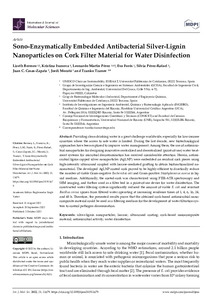Por favor, use este identificador para citar o enlazar este ítem:
https://repositorio.uca.edu.ar/handle/123456789/15203| Título: | Sono-enzymatically embedded antibacterial silver-lignin nanoparticles on cork filter material for water disinfection | Autor: | Bermeo, Lizeth Ivanova, Kristina Pérez, Leonardo Martín Forés, Eva Pérez Rafael, Sílvia Casas Zapata, Juan C. Morató Farreras, Jordi Tzanov, Tzanko |
Palabras clave: | AGUA POTABLE; DESINFECCIÓN DEL AGUA; ACTIVIDAD ANTIMICROBIANA; NANOCOMPUESTO A BASE DE CORCHO MATERIAL; NANOPARTÍCULAS DE PLATA Y LIGNINA; LACASA; REVESTIMIENTO DE ULTRASONIDO | Fecha de publicación: | 2022 | Editorial: | Multidisciplinary Digital Publishing Institute | Cita: | Bermeo, L. et al. Sono-enzymatically embedded antibacterial silver-lignin nanoparticles on cork filter material for water disinfection [en línea]. International Journal of Molecular Sciences. 2022, 23, 11679. Disponible en: https://repositorio.uca.edu.ar/handle/123456789/15203 | Resumen: | Abstract: Providing clean drinking water is a great challenge worldwide, especially for low-income countries where the access to safe water is limited. During the last decade, new biotechnological approaches have been explored to improve water management. Among them, the use of antimicrobial nanoparticles for designing innovative centralized and decentralized (point-of-use) water treatment systems for microbial decontamination has received considerable attention. Herein, antimicrobial lignin capped silver nanoparticles (AgLNP) were embedded on residual cork pieces using high-intensity ultrasound coupled with laccase-mediated grafting to obtain biofunctionalized nanomaterial. The developed AgLNP-coated cork proved to be highly efficient to drastically reduce the number of viable Gram-negative Escherichia coli and Gram-positive Staphylococcus aureus in liquid medium. Additionally, the coated-cork was characterized using FTIR-ATR spectroscopy and SEM imaging, and further used as a filter bed in a point-of-use device for water disinfection. The constructed water filtering system significantly reduced the amount of viable E. coli and resistant Bacillus cereus spores from filtered water operating at increasing residence times of 1, 4, 6, 16, 24, and 48 h. Therefore, the presented results prove that the obtained cork-based antimicrobial nanocomposite material could be used as a filtering medium for the development of water filtration system to control pathogen dissemination. | URI: | https://repositorio.uca.edu.ar/handle/123456789/15203 | ISSN: | 1422-0067 (online) | Disciplina: | QUIMICA | Derechos: | Acceso abierto | Fuente: | International Journal of Molecular Sciences Vol. 23, 11679, 2022 |
| Aparece en las colecciones: | Artículos |
Ficheros en este ítem:
| Fichero | Descripción | Tamaño | Formato | |
|---|---|---|---|---|
| sono-enzymatically-embedded.pdf | 2,64 MB | Adobe PDF |  Visualizar/Abrir |
Visualizaciones de página(s)
57
comprobado en 27-abr-2024
Descarga(s)
47
comprobado en 27-abr-2024
Google ScholarTM
Ver en Google Scholar
Este ítem está sujeto a una Licencia Creative Commons

